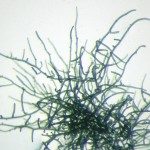Link to Pubmed [PMID] – 29449488
Science 2018 02;359(6377):779-782
Current textbook knowledge holds that the structural scope of ribosomal biosynthesis is based exclusively on α-amino acid backbone topology. Here we report the genome-guided discovery of bacterial pathways that posttranslationally create β-amino acid-containing products. The transformation is widespread in bacteria and is catalyzed by an enzyme belonging to a previously uncharacterized radical-adenosylmethionine family. We show that the β-amino acids result from an unusual protein splicing process involving backbone carbon-carbon bond cleavage and net excision of tyramine. The reaction can be used to incorporate diverse and multiple β-amino acids into genetically encoded precursors inIn addition to enlarging the set of basic amino acid components, the excision generates keto functions that are useful as orthogonal reaction sites for chemical diversification.



